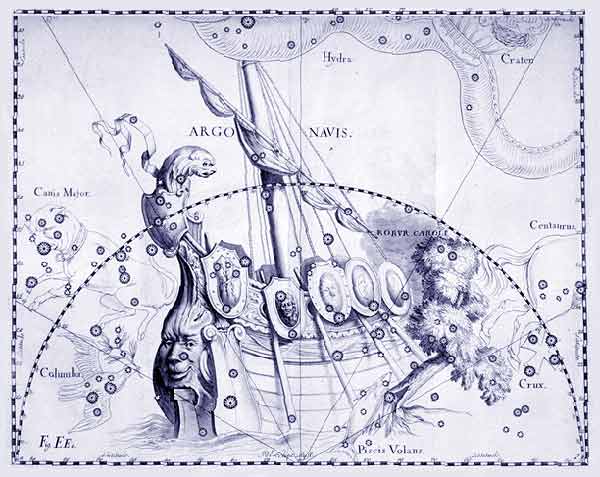
MYTHOLOGY
The mythical ship Argo was a oar and sail boat (fifty),with which Giasone and the Argonauts navigate in order to recover the gold vello of gold (see Aries). Before the enterprise, the hero entrusted with Argo (from which the name of the ship) to construct a big ship of along course (for of Eratostene and Manilio it was the biggest ship: the effective supremacy is instead attributing to the ship constructed from Danao), resisting to all the insidie that a travel of the kind would have involved. Argo, with the aid of the goddess Atena (for the Roman Minerva, the goddess of the wisdom), protecting of the mission, constructed it in the port of Pagase (Tessaglia), using the wood gained from Monte Pelio. Atena added on the prow a beam coming from the oracolo of Zeus to Dodona in Western Greece: this beam had the power to predict and to aid the minds. Finished the construction of the ship, Giasone assembled the fifty most braves heroes, comprised Castores, Polluce, Orfeo, same Argo and even Eracle (Ercole) that interrupted its hards work in order to join to the Argonauts; therefore sailed to the time of the Colchide. The ship faced with succeeding all the snarer met along the way, resisting to the more devastating storms and maintaining a high speed. One of the hardest tests that the ship had to support was that the Cozzanti Cliffs, or Simplegadi, placed guard of the entrance of the Sea Nero: they consisted in two sliding doors of rock that closed to passing of whichever thing in the middle, crushing it and destroying it. Shortly before arriving to this, the Argonauts freed a dove and they left it to fly towards the Cliffs that to its passage at once closed breaking the tail of the bird, than however he succeeded to survive. In the precise moment in which Cliffs began to reopen itself, the Argonauts rowed fast in order exceeding them and succeeded in the attempt losing only the mascotte, crushed from the Cliffs that, returned in the departure position, reclosed ready. Argo became therefore the only boat that succeeded to exceed this unsurmountable obstacle and the Cliffs, after its passage, did not close more. The ship reached in the Colchide where Giasone recovered the vello of gold and it behind brought back in Greece, navigating along an alternative path. At last the hero to Corinto pulled in dry the ship and he made a monument, dedicating it to the God Poseidone (for the Roman Neptune, the God of the sea). In sky the ship is visible only in its posterior part: the prow, for the ancient cartographers, would disappear behind a fog bank or cozzanti Cliff (as it tells to us Arato). It said then that Giasone in old age returned to Corinto and salted on the ship in order to remember its enterprises, but its wood was so marches that not resisting the weight, it collapsed killing the hero. Poseidone therefore put the fragments in sky. The enormous constellation of the Ship Argon then was subdivided for comfort in three parts (Carena, Poppa, Vela) from the French astronomer Nicolas Louis de Lacaille in the eighteenth century. The most brightest star of the constellations of the Ship Argo, and the second in all celestial sky, is Canopo, that it takes the name from the helmsman of Menelao. To the return from Troy the fleet of the Greek king was dragged from a storm on the egizie rivers, where Canopo died bitten from a snake. Therefore in its honor it came to it consecrated a star and it came constructed a funeral monument where born the city of Canopo, now Arabic Abukir.